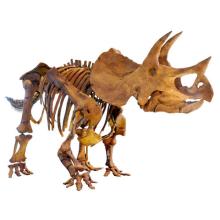Triceratops horridus
Common name:
Triceratops
Suborder:
Neornithischia
Order:
Ornithischia
Class:
Dinosauria
Triceratops horridus
Common name:
Triceratops
Suborder:
Neornithischia
Order:
Ornithischia
Class:
Dinosauria
Triceratops horridus
Common name:
Triceratops
Suborder:
Neornithischia
Order:
Ornithischia
Class:
Dinosauria
Order-Animalia: Ornithischia
Ornithischia (/ˌɔːrnəˈθɪski.ə/) is an extinct clade of mainly herbivorous dinosaurs characterized by a pelvic structure superficially similar to that of birds. The name Ornithischia, or "bird-hipped", reflects this similarity and is derived from the Greek stem ornith- (ὀρνιθ-), meaning "bird", and ischion (ἴσχιον), meaning "hip". However, birds are only distantly related to this group as birds are theropod dinosaurs. Ornithischians with well known anatomical adaptations include the ceratopsians or "horn-faced" dinosaurs (e.g. Triceratops), the pachycephalosaurs or "thick-headed" dinosaurs, the armored dinosaurs (Thyreophora) such as stegosaurs and ankylosaurs, and the ornithopods. There is strong evidence that certain groups of ornithischians lived in herds, often segregated by age group, with juveniles forming their own flocks separate from adults. Some were at least partially covered in filamentous (hair- or feather- like) pelts, and there is much debate over whether these filaments found in specimens of Tianyulong, Psittacosaurus, and Kulindadromeus may have been primitive feathers.

